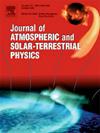Combined influence of sudden stratospheric warming (SSW) and geomagnetic storm forcing on reduced TEC over low-latitude Northern Africa
IF 1.9
4区 地球科学
Q3 GEOCHEMISTRY & GEOPHYSICS
Journal of Atmospheric and Solar-Terrestrial Physics
Pub Date : 2025-09-10
DOI:10.1016/j.jastp.2025.106621
引用次数: 0
Abstract
This study analyzes total electron content (TEC) variations over the equatorial and low-latitude region in the Northern African during the January 2013 sudden stratospheric warming (SSW) and concurrent geomagnetic storm to assess their combined impacts on equatorial electrojet (EEJ) and the equatorial ionization anomaly (EIA).
During the major SSW phase (12–16 January 2013), the ionosphere exhibited pronounced semidiurnal variations in TEC and inferred E X B drift, driven by the amplification of atmospheric tides. These tidal enhancements strengthened eastward electric fields, increasing the inferred upward E × B drifts, leading to a poleward shift in the northern EIA crest and TEC significantly enhanced by 71 % relative to non-SSW and SSW onset conditions.
During the geomagnetic storm overlapping the 2013 SSW event on 17–18 January 2013, westward penetration electric fields (PPEFs) dominated the low-latitude ionosphere, counteracting SSW-driven daytime eastward fields. Combined with equatorward thermospheric winds, these effects suppressed SSW-induced tidal enhancements, reducing upward inferred E × B drifts, decreasing TEC, and shifting the EIA crest equatorward.
This study reveals regionally distinct ionospheric responses to SSW and geomagnetic storms, emphasizing the need to integrate lower atmospheric and magnetospheric forcings in space weather models, particularly for under-observed African longitudes.
Plain Language Summary
This study examines how the low-latitude ionosphere over Africa responded to a major sudden stratospheric warming (SSW) event that occurred in January 2013, coinciding with a moderate geomagnetic storm. Using observations from ground-based GPS receivers and magnetometers, we explore how changes in the upper atmosphere were influenced by both the SSW and the geomagnetic storm. Our results show that the ionosphere experienced a significant reduction in total electron content (TEC) and a weakening of the equatorial ionization anomaly. These changes were caused by the combined effects of storm-time electric fields, thermospheric winds, and enhanced atmospheric tides generated during the SSW. We also observed clear semi-diurnal patterns in the data, highlighting the role of amplified tidal waves during this period. This study emphasizes that both space weather (geomagnetic storms) and atmospheric weather (SSW events) can interact to drive complex changes in the ionosphere, especially over the African sector.
平流层突然变暖(SSW)和地磁风暴强迫对北非低纬度地区TEC减少的联合影响
本文分析了2013年1月平流层突然变暖(SSW)和同期地磁风暴期间北非赤道和低纬度地区总电子含量(TEC)的变化,以评估它们对赤道电喷流(EEJ)和赤道电离异常(EIA)的综合影响。在主要的SSW阶段(2013年1月12日至16日),电离层在大气潮汐放大的驱动下表现出明显的TEC和推断的E X B漂移的半日变化。这些潮汐增强增强了东向电场,增加了推断的E × B向上漂移,导致北部EIA波峰极移,TEC相对于非SSW和SSW开始条件显著增强了71%。在2013年1月17-18日与2013年SSW事件重叠的地磁风暴期间,向西穿透电场(ppef)主导了低纬度电离层,抵消了SSW驱动的白天向东场。与赤道方向的热层风相结合,这些效应抑制了海温引起的潮汐增强,减少了向上推断的E × B漂移,减少了TEC,并使EIA波峰向赤道方向移动。这项研究揭示了电离层对SSW和地磁风暴的区域性不同响应,强调需要在空间天气模式中整合低层大气和磁层强迫,特别是对观测不足的非洲经度。本研究考察了非洲低纬度电离层如何应对2013年1月发生的一次重大的平流层突然变暖(SSW)事件,该事件与一次中度地磁风暴同时发生。利用地面GPS接收机和磁力计的观测资料,我们探讨了SSW和地磁风暴对高层大气变化的影响。结果表明,电离层总电子含量(TEC)显著降低,赤道电离异常减弱。这些变化是由风暴时电场、热层风和SSW期间产生的增强的大气潮汐的综合影响引起的。我们还在数据中观察到清晰的半日模式,突出了在此期间放大的潮汐波的作用。这项研究强调,空间天气(地磁风暴)和大气天气(SSW事件)可以相互作用,推动电离层的复杂变化,特别是在非洲地区。
本文章由计算机程序翻译,如有差异,请以英文原文为准。
求助全文
约1分钟内获得全文
求助全文
来源期刊

Journal of Atmospheric and Solar-Terrestrial Physics
地学-地球化学与地球物理
CiteScore
4.10
自引率
5.30%
发文量
95
审稿时长
6 months
期刊介绍:
The Journal of Atmospheric and Solar-Terrestrial Physics (JASTP) is an international journal concerned with the inter-disciplinary science of the Earth''s atmospheric and space environment, especially the highly varied and highly variable physical phenomena that occur in this natural laboratory and the processes that couple them.
The journal covers the physical processes operating in the troposphere, stratosphere, mesosphere, thermosphere, ionosphere, magnetosphere, the Sun, interplanetary medium, and heliosphere. Phenomena occurring in other "spheres", solar influences on climate, and supporting laboratory measurements are also considered. The journal deals especially with the coupling between the different regions.
Solar flares, coronal mass ejections, and other energetic events on the Sun create interesting and important perturbations in the near-Earth space environment. The physics of such "space weather" is central to the Journal of Atmospheric and Solar-Terrestrial Physics and the journal welcomes papers that lead in the direction of a predictive understanding of the coupled system. Regarding the upper atmosphere, the subjects of aeronomy, geomagnetism and geoelectricity, auroral phenomena, radio wave propagation, and plasma instabilities, are examples within the broad field of solar-terrestrial physics which emphasise the energy exchange between the solar wind, the magnetospheric and ionospheric plasmas, and the neutral gas. In the lower atmosphere, topics covered range from mesoscale to global scale dynamics, to atmospheric electricity, lightning and its effects, and to anthropogenic changes.
 求助内容:
求助内容: 应助结果提醒方式:
应助结果提醒方式:


